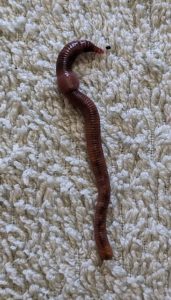By Emmy Ulmschneider
and Debbie Roland
Master Gardeners
Gardeners and worms go hand in hand but not all worms are the same. We commonly use one type of worm, Red Wigglers, Eisenia fetida, for vermiculture (worm composting) because they can quickly convert our vegetable scraps into compost. The worms we commonly see burrowing in our gardens and natural areas are the larger nightcrawlers or European Worms, Lumbricus spp. I already knew these introduced European earthworms threaten the hardwood forests of my youth. So, I attended a talk by Ashley Morgan-Olvera entitled Texas Gardeners Beware, Invasive Worms are Encroaching! at the 2023 Texas Master Gardener Conference to find out more.

Native earthworms were largely eliminated in places that were glaciated. Our current earthworm populations are not native to America but came over with plant material brought by early settlers and later in imported horticultural plants, soil, mulch, and common bait worms. We know now that these non-native worms are destroying our native hardwood forests by consuming the rich leaf litter, decreasing nutrients, and changing the soil profile. In a native hardwood forest, the fallen leaves decompose slowly, forming a spongy, organic layer that nurtures native understory wildflowers and shrubs. Invasive worms consume and deplete this layer, changing how the forest looks and decreasing forest biodiversity. We commonly use introduced worms in vermiculture, agricultural areas, home gardens, and as bait. What I learned was that even in Texas, we need to do all we can to keep these earthworms out of our forests:
“It is very important to note that while European earthworms are naturalized and readily used in garden and agricultural settings, they will also cause harm to our forested areas. If you are using European earthworms, please keep them focused in your area and never release them into wooded areas or aquatic habitats.”
Texas Invasives Database, tinyurl.com/nspn3tk3
You may wonder what this has to do with arid West Texas, but we have gardens and yards where introduced worms thrive, we may practice vermiculture or fish with bait worms. And we buy or grow plants that have the potential to transport these worms around; that is how they arrived in the first place.
Morgan-Olivera also discussed another worrisome, extremely invasive species of worm: Jumping Worms, Amynthus spp. These worms arrived in horticulture material from Asia and are sold as bait under the name Alabama Jumper or Crazy Worm. Although they arrived in the northeastern United States around 1910, they are rapidly spreading, have been found in 20 states, and were reported last year in the Dallas-Fort Worth area. These worms remove all organic matter from soil, severely degrading the topsoil which increases erosion and decreases soil fertility and water retention. They are identified from the naturalized European Earthworms by their wild behavior and white clitellum, a thickened area near the head. For more information see: tinyurl.com/nspn3tk3
Morgan-Olivera suggests these steps to prevent the spread of highly invasive Jumping Worms:
- Do not buy worms advertised as jumping worms.
- Dispose of unwanted worms in the trash not the environment.
- Check plants, or unsterilized compost, mulch, or soil materials before using.
She asks for citizen help in reporting any possible sightings of the jumping worms in Texas. You can send an email with photo and location to: tsusinvasives.org/home/contact
If you have questions, call the AgriLife office in Odessa at 498-4071 or in Midland at 686-4700. Additional information, and our blog for access to past articles, is available at westtexasgardening.org. Click on “Resources.”




